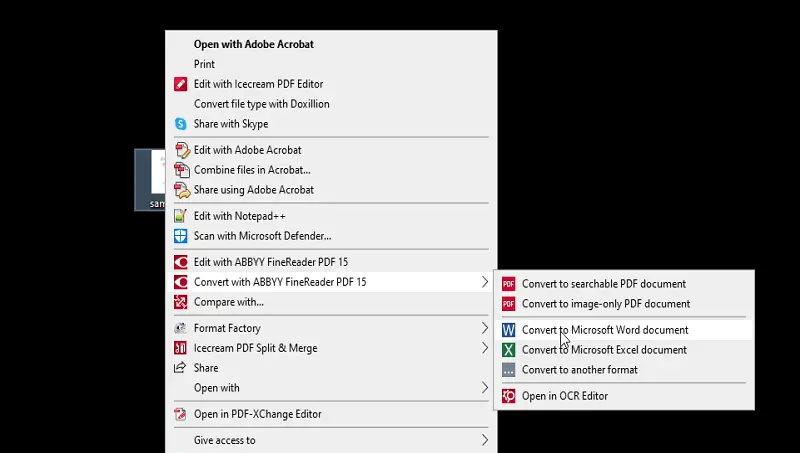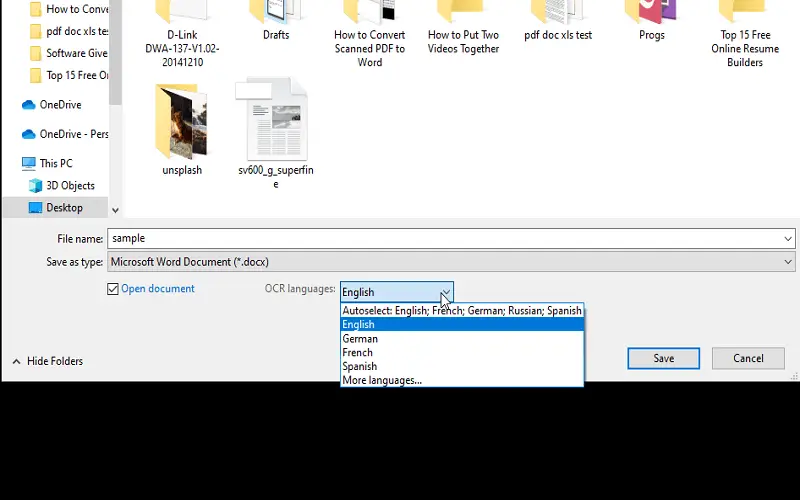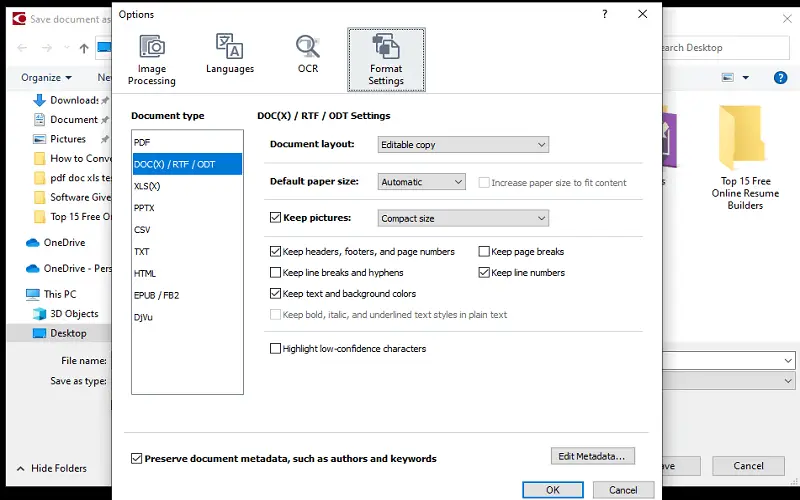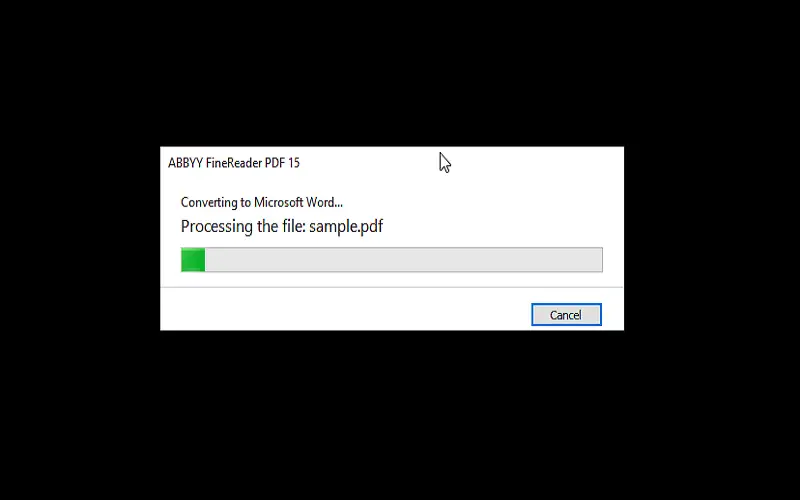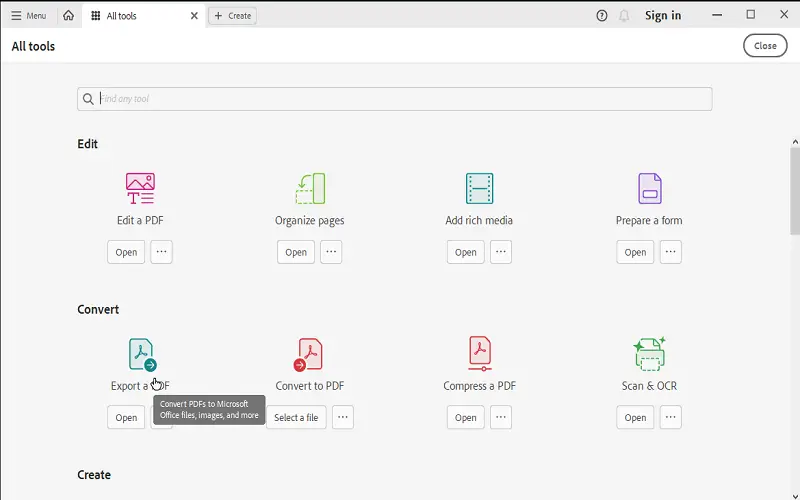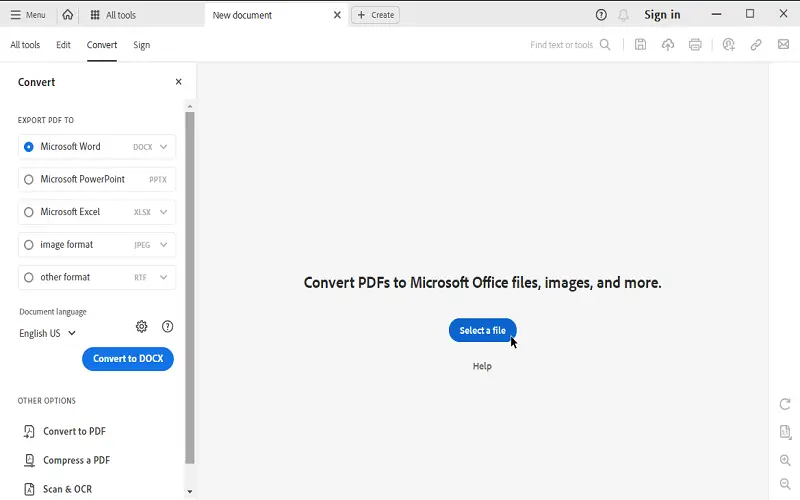Convert Scanned PDF to Word Easily
In today's digital era, being able to convert scanned PDF to the Word document is a handy skill. This process allows you to make edits to scanned PDF files easily.
If you've ever received a scanned PDF or had to work with an image-based document, this article is your go-to guide. We'll walk you through simple steps and show you different tools to convert the scanned PDF to text, making your documents more flexible and accessible.
Working with scanned PDFs can be challenging due to their image-based content, lack of character recognition (OCR), and large file sizes. Editing, searching, and collaborating on these documents can be cumbersome.

How we picked scanned PDF to Word converters
Selecting the right PDF text recognition tool is crucial for efficient and accurate conversion of scanned PDF files to Word. In curating the recommendations for this guide, we considered several key factors:
- OCR accuracy. We evaluated each tool by testing its ability to recognize and convert text accurately from scanned PDFs.
- Supported formats. We considered the versatility of each OCR tool in handling various file formats.
- Output formatting. We gave preference to the applications that consistently maintained the formatting of the original PDF during the conversion process.
By carefully evaluating these criteria, we aimed to provide a curated list of scanned PDF to text converters that cater to diverse user needs, ensuring a smooth and reliable experience when converting scanned PDF to Word documents.
Option 1. PDF Candy Desktop
PDF Candy provides a user-friendly solution for converting scanned documents into Word with speed and accuracy. The output files maintain high quality, preserving the original text, images, tables, and formatting.
How to recognize text in PDF with PDF Candy Desktop
- Download and install the PDF software on your computer.
- Open the application and select the "OCR" option.
- Upload the scanned PDF file you want to convert into the program.
- Select the original document language and output format (DOC or DOCX). Then click the "Convert" button to turn the PDF scan to text.
- Once completed, the file will be downloaded to the selected directory.

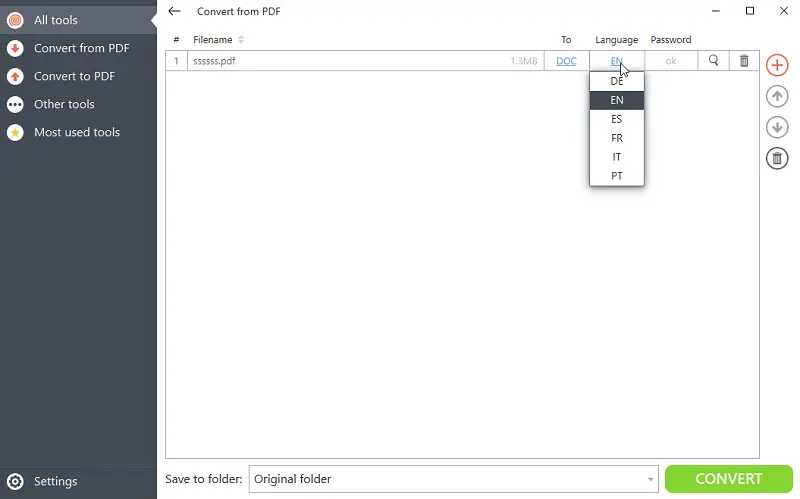
Pros:
- Versatility in output formats. The OCR tool allows you to convert files to DOC, DOCX, ODT, and RTF.
- Maintains high quality. The output files retain excellent quality, preserving the integrity of the original text.
- User-friendly interface. The software features an intuitive interface, making it accessible to users with varying levels of technical expertise.
- Multifunctional toolset. Beyond conversion, users can split or merge PDFs, add or remove passwords, rotate pages, extract images, and perform other actions as needed.
- Efficient batch processing. The OCR PDF to Word converter supports batch processing, enabling users to convert multiple scanned documents in one go.
Cons:
- Can be used only on Windows devices.
Option 2. Abbyy FineReader
Abbyy FineReader is an OCR software that enables users to convert scanned PDFs, images, and documents into editable content. It is equipped with three levels of accuracy (full-text, field-level, and zonal) and offers the ability to recognize text in tables and forms.
How to convert PDF to text with the help of Abbyy FineReader
- Install the program on your device.
- Choose the scanned PDF that requires conversion, right-click on it, and select "Convert with Abbyy Finereader PDF".
- In the drop-down menu pick "Convert to Microsoft Word Document".
- Specify the OCR languages and adjust the settings for the PDF text recognition.
- Once completed, hit "Save".
Pros:
- Can recognize a wide range of languages, including English, Spanish, German, and French.
- Supports multiple output formats such as Microsoft Word or Excel files, HTML, XML, and more.
- Provides an automated layout retention feature.
Cons:
- The PDF OCR application can be resource-intensive, especially when processing large documents or batches of files.
- The software installation file size is relatively large.
Early OCR struggled with font variations, but advances in computing and machine learning have significantly improved accuracy.
Option 3. Adobe Acrobat
Adobe Acrobat has immense capabilities for creating, managing, and editing PDF documents. Additionally, it enables you to convert the scanned PDF to customizable the Word document. Just a few basic steps are needed to turn any PDF into an alterable DOC.
How to convert scanned document to Word in Adobe Acrobat
- Open your scanned document in the program.
- Click the "Tools" tab. Choose "Export PDF" from the menu.
- Select "Microsoft Word" from the available options.
- Pick the language of the original document. Press "Convert to DOC".
- Enter a name for your new file and choose a location for it on your computer, then click "Save".
- Your PDF has now been converted into a Word document for editing or further formatting.
Pros:
- Compatible with Mac and Windows.
- Able to recognize a mixture of fonts.
Cons:
- Converting PDF to Word is not free, and the subscription is quite costly.
- PDF text recognition is not always accurate.
- You may lose some formatting in the process, such as tables and images.
- It may not be suitable for larger files that contain more complex formatting.
Option 4. SmallPDF
SmallPDF is a well-known online platform providing users with the ability to quickly convert PDF files into other formats. One of the most useful features it offers is turning the PDF scan into the text.
How to convert scanned PDF to Word on SmallPDF website
- Open the converter.
- Click the "Choose Files" button and select the scanned PDF you want to convert.
- Select "Convert text from scans".
- Await the completion of the process.
- Download your converted document when it is ready.
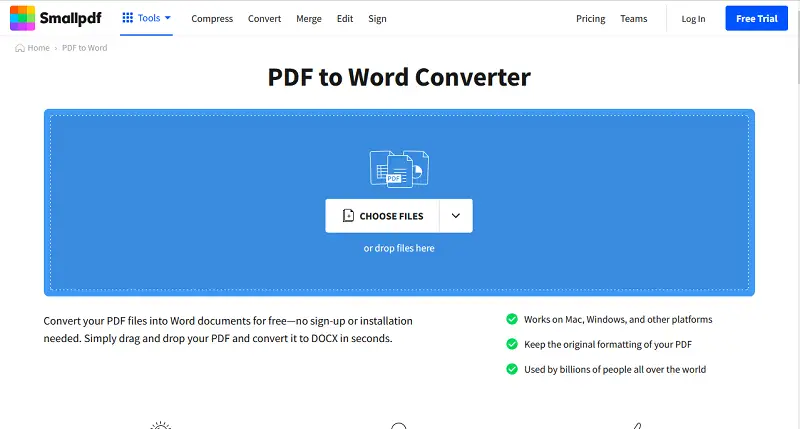
Pros:
- The steps are easy to follow, making it ideal for novice users.
- Can rapidly transform scanned documents into Word.
- All uploaded files are encrypted and stored securely in the cloud.
Cons:
- The OCR tool is available only in the PRO version.
- The converted Word document may have a lower quality than the original PDF file.
Option 5. PDF2Go
PDF2Go is an online tool that helps users quickly convert PDF into different formats. It includes a feature that allows you to turn scanned documents into editable text, making it easier to work with files that were originally images.
How you can convert a scanned PDF to Word with PDF2Go
- Open the PDF to Word converter by PDF2Go.
- Click the "Choose File" button and upload your scanned pages.
- Select the "Convert with OCR" option to extract text from the scan.
- Wait for the tool to process the file and convert it to Word.
- Once it is done, click the download link to save your new document.
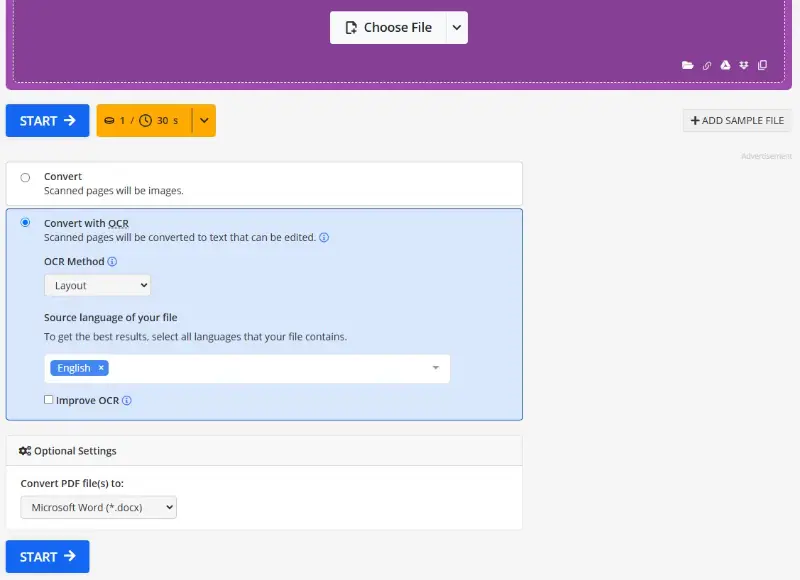
Pros:
- Simple and easy-to-follow steps, ideal for beginners.
- Can quickly turn scanned PDFs into Word documents.
- Files are handled securely, with a focus on privacy during processing.
Cons:
- The free trial allows for 16 credits only.
Understanding scanned PDFs
Scanned PDFs are documents created by scanning physical documents, such as pages from books, forms, or handwritten notes, into a digital format.
When you scan a document, it's converted into an image (usually JPEG or TIFF). These files are then compiled into a PDF document.
Challenges associated with working with scanned PDFs include:
- Searchability. Without OCR, it's impossible to search for specific terms or phrases within scanned PDFs.
- Editability. Making changes to the content of such documents requires either retyping the text or using OCR. This can be time-consuming and may not always produce accurate results, especially with complex layouts or handwritten text.
- File size. Scanned PDFs can have large file sizes due to the inclusion of image data. It can make them cumbersome to store, share, and work with.
Why convert scanned PDF to Word
Converting scanned PDF to text offers several compelling benefits that make it a valuable process for a variety of purposes. Here are some key reasons why individuals and organizations choose to convert scanned PDFs to Word:
- PDF text recognition allows users to modify the content, making it easy to update, correct, or customize the document as needed.
- Turning into Word enables the creation of searchable documents, allowing users to find specific content in a PDF using search functions.
- The ability to recognize text in a PDF facilitates easy content extraction, enabling users to repurpose information for various needs.
- Word documents support version control, so it is simpler to track changes and review document history.
FAQ
- How accurate is OCR technology?
- OCR technology is generally very precise. However, its accuracy can depend on several factors such as the quality of the PDF file, the resolution of the scan, and the layout complexity. For best results, it's always recommended to use high-quality scans with clear text when attempting conversions with an OCR tool.
- Can I convert any scanned PDF to Word?
- Most OCR PDF to Word converters, including those discussed in the article, can handle a wide range of scanned PDFs.
- Will the formatting of the original document be preserved after conversion?
- PDF text recognition tools strive to maintain the view of the original file, but results may vary. Complex layouts or fonts might require additional adjustments post-conversion.
- What can I do if the conversion results in errors or inaccuracies?
- If errors occur during conversion, you can manually edit the Word document after the process. Additionally, checking and adjusting the settings of the OCR program might improve the resulting file.
- Can I turn handwritten text into scanned PDFs to Word using OCR?
- OCR services are primarily designed for printed or typed text recognition. While some may offer limited support for handwritten text, sharpness can vary.
- How do I handle scanned PDFs with multiple languages?
- OCR tools typically support multiple languages, but for the best results, you must ensure that the program is set to recognize the correct language of the text in the scanned PDF.
- How can I improve the quality of the converted document?
- After the OCR process, proofread the text for any errors or misrecognitions. You can also manually adjust the formatting, such as correcting the placement of images, tables, or text blocks.
Convert scanned PDF to Word: Tips
- Check image quality. Ensure that the scanned PDF has good image quality. Clear and legible scans result in more accurate text recognition during the conversion process.
- Verify language support. Confirm that the OCR PDF to Word converter supports the language used in your scanned document. Some apps may have better precision with certain languages.
- Understand OCR settings. Adjust parameters like image enhancement, and text recognition settings for optimal results.
- Explore additional features. Some OCR tools offer features beyond simple conversion, such as PDF splitting, merging, or translation.
Some OCR engines offer real-time translation features, recognizing and translating text instantly.
Conclusion
In conclusion, converting scanned PDF to Word opens up a realm of possibilities for efficient document management and editing. Choosing the right platform allows individuals to seamlessly integrate scanned documents into their digital workflows.
By following the options and tips shared in this guide, users can confidently navigate the conversion process, transforming static documents into editable, and versatile assets for both personal and professional use.


